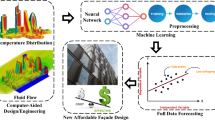Abstract
In the design and placement of radio base station transmitters, the accurate field signal power prediction and modelling is of critical importance. In this work, an adaptive neural network predictor which combines multilayer perception (MLP) and adaptive linear element (Adaline) is proposed for enhanced signal propagation loss prediction in microcellular urban environments. The prediction accuracy of the proposed Hybrid adaptive neural network predictor has been tested and evaluated using experimental field strength data acquired from LTE radio network environment with mixed residential, commercial and cluttered building structures. By means of first order statistical performance evaluation metrics, namely, regression coefficient (R), root mean squared error, standard deviation and mean absolute error, the proposed adaptive hybrid approach provide a better prediction accuracy compared to the standard MLP ANN prediction approach. The superior performance of the hybrid neural predictor can be attributed to its capability to learn, adaptively respond and predict the fluctuating patterns of the reference propagation loss data during training.










Similar content being viewed by others
References
Amaldi, E., Capone, A., & Malucelli, F. (2008). Radio planning and coverage optimization of 3G cellular networks. Wireless Networks, 14(4), 435–447.
Isabona, J., & Srivastava, V. M. (2017). Coverage and link quality trends in suburban mobile broadband HSPA network environments. Wireless Personal Communications, 2017, 1–14.
Neskovic, A., & Neskovic, N. (2010). Microcell electric field strength prediction model based upon artificial neural networks. International Journal Electronics and Communication (AEU), 64, 733–738.
Ostlin, E., Zepernick, H.-J., & Suzuki, H. (2010). Macrocell path loss prediction using artificial neural networks. IEEE Transactions on Vehicular Technology, 59(6), 2735–2747.
Neskovic, A., Neskovic, N., & Paunovic, D. (2000). Indoor electric field level prediction model based on the artificial neural networks. IEEE Communication Letters, 4(6), 190–192.
Popescu, I., Nikitopoulos, D., Constantinou, P., & Nafornita, I. (2006). ANN prediction models for outdoor environment. In Proceeding of 17th IEEE international symposium on personal, indoor, mobile radio communication, Helsinki, Finland.
Sharma, S., Kumar, V., & Kumar, R. (2012). Spervised online asaptive control of inverted pendulum system using ADALINE artificail neural networks with varying system parameters and external disturbance. International Journal of Interlligent Systems and Applications, 8, 53–61.
Gao, X. M., Gao, X. Z., Tanskanen, J. M. A., & Ovaska, S. J. (1997). Power prediction in mobile communication systems using an optimal neural-network structure. IEEE Transactions on Neural Networks, 8(6), 1145–1455.
Ardalani, N., Khoogar, A., & Roohi, H. (2007). A comparison of Adaline and MLP neural network based predictors in SIR estimation in mobile DS/CDMA systems, world academy of science, engineering and technology. International Journal of Electrical, Computer, Energetic, Electronic and Communication Engineering, 1(9), 1382–1387.
Gschwendtner, B. E., & Landstorfer, F. M. (1996). Adaptive propagation modeling using a hybrid neural technique. Electronics Letters, 32(3), 162–164.
Isabona, J., & Srivastava, V. M. (2016). Hybrid neural network approach for predicting signal propagation loss in urban microcells. In Proceeding of 2016 IEEE region 10 humanitarian technology conference (R10-HTC), Agra, India.
Isabona, J., & Srivastava, V. M. (2016). A neural network based model for signal coverage propagation loss prediction in urban radio communication environment. International Journal of Applied Engineering Research, 11(22), 11002–11008.
Yonaba, H., Anctil, F., & Fortin, V. (2010). Comparing sigmoid transfer functions for neural network multistep ahead streamflow forecasting. Journal of Hydrologic Engineering, 15(4), 275–283.
Torre, A., Garcia, F., Moromi, I., Espinoza, P., & Acuna, L. (2015). Prediction of compression strength of high performance concrete using artificial neural networks. Journal of Physics: Conference Series, 582, 1–6.
Author information
Authors and Affiliations
Corresponding author
Additional information
Publisher's Note
Springer Nature remains neutral with regard to jurisdictional claims in published maps and institutional affiliations.
Rights and permissions
About this article
Cite this article
Ebhota, V.C., Isabona, J. & Srivastava, V.M. Environment-Adaptation Based Hybrid Neural Network Predictor for Signal Propagation Loss Prediction in Cluttered and Open Urban Microcells. Wireless Pers Commun 104, 935–948 (2019). https://doi.org/10.1007/s11277-018-6061-2
Published:
Issue Date:
DOI: https://doi.org/10.1007/s11277-018-6061-2




